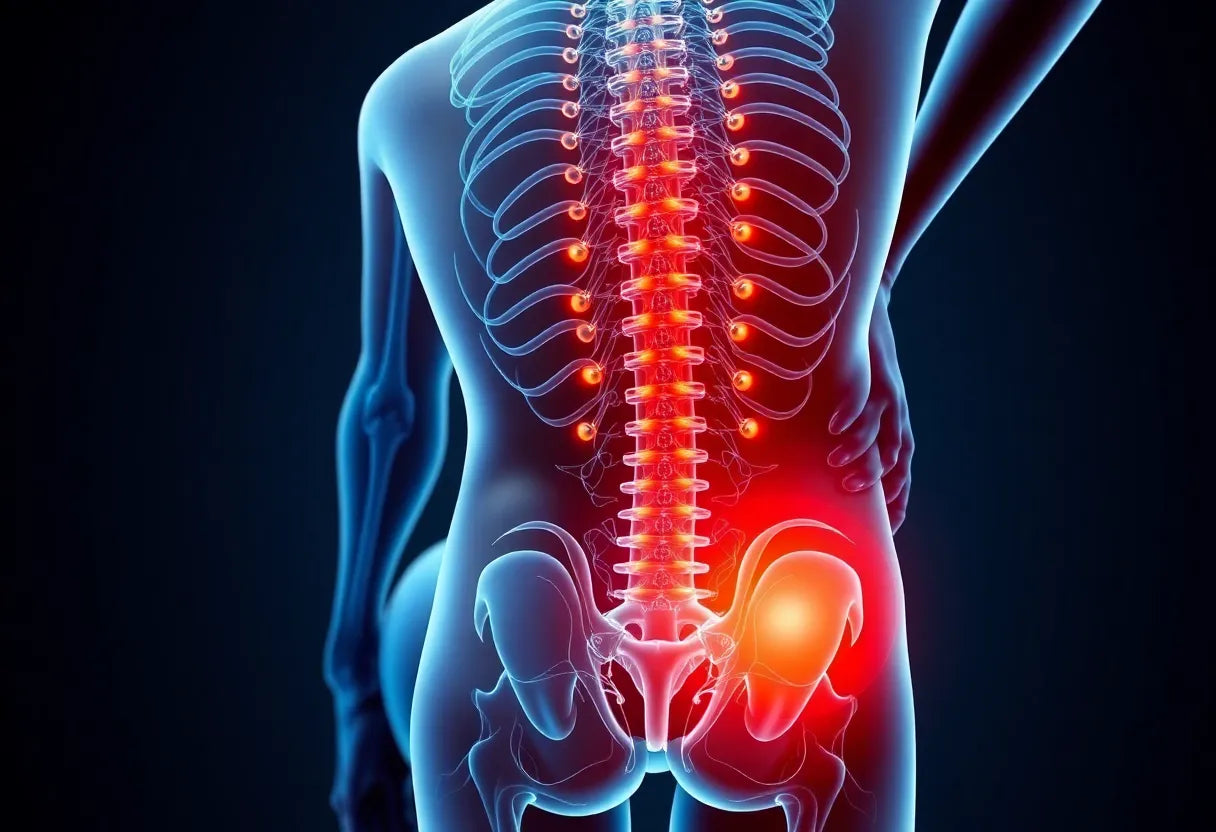Lower back pain is a common issue that affects millions of people worldwide, impacting their daily activities and overall quality of life. Whether it's due to prolonged sitting, improper posture, or physical exertion, the discomfort can be debilitating. Understanding the prevalence and impact of lower back pain is crucial in addressing it effectively. Fortunately, targeted lower back exercises can offer significant relief and even prevent future occurrences.
Understanding lower back pain
Lower back pain can arise from various factors, including muscle strain, poor posture, or underlying medical conditions. It can limit mobility, reduce productivity, and affect mental well-being. Addressing this pain is essential not only for relief but also for preventing chronic conditions. Incorporating specific exercises into your routine can strengthen the muscles supporting the spine, improve flexibility, and enhance overall back health.
Exercises designed for the lower back are not just about alleviating pain; they play a vital role in prevention. By regularly engaging in these exercises, you can build a stronger core and back, which are essential for maintaining a healthy spine. This proactive approach can significantly reduce the risk of future back problems.
The role of exercise in pain management
Exercise is a powerful tool in managing and alleviating lower back pain. Specific exercises focus on strengthening the lower back and core muscles, which support the spine and improve posture. By enhancing these areas, you can reduce strain on the back and decrease the likelihood of pain.
Regular exercise not only addresses existing pain but also contributes to maintaining spinal health. It aids in improving flexibility, increasing strength, and promoting better posture. These benefits are crucial for anyone looking to manage or prevent lower back pain effectively.
This guide focuses on practical, evidence-based exercises that are easy to incorporate into your daily routine. By following these exercises, you can take a proactive approach to your back health, ensuring long-term relief and prevention. Whether you're experiencing pain now or looking to prevent it, these exercises are a valuable addition to your wellness regimen.
evidence-based exercise recommendations
When it comes to alleviating lower back pain, selecting the right exercises is crucial. Evidence-based exercise choices ensure that you're engaging in activities that have been scientifically proven to be effective. Numerous systematic reviews and studies have highlighted the benefits of specific exercises in reducing lower back pain and improving overall spinal health.
Research consistently supports the effectiveness of exercises that target the core and posterior chain, which includes muscles like the glutes and hamstrings. These exercises not only alleviate pain but also enhance stability and prevent future injuries. By focusing on evidence-based recommendations, you can be confident that your efforts will yield positive results.
exercise list and instructions
exercise 1: bird dog
The Bird Dog exercise is renowned for enhancing stability and coordination while minimizing spinal compression. It primarily targets the multifidus muscles, which play a crucial role in maintaining spinal health.
How to Perform: Begin on all fours, ensuring your wrists are aligned under your shoulders and knees under your hips. Extend your right arm and left leg simultaneously, keeping your spine neutral. Hold the position for a few seconds, then return to the starting position and alternate sides. Repeat for 10-15 repetitions on each side.
exercise 2: bridge
The Bridge exercise is effective for activating the posterior chain, including the glutes, hamstrings, and lower back. This exercise helps in building strength and stability in the lower back region.
How to Perform: Lie on your back with your knees bent and feet flat on the floor. Engage your core and lift your hips towards the ceiling, forming a straight line from your knees to your shoulders. Squeeze your glutes at the top and hold for a few seconds before lowering back down. Aim for 10-15 repetitions.
exercise 3: pelvic tilt
The Pelvic Tilt is a simple yet effective exercise for core activation and pain relief. It helps in improving the flexibility of the lower back and strengthening the abdominal muscles.
How to Perform: Lie on your back with knees bent and feet flat. Gently tilt your pelvis upward, pressing your lower back into the floor. Hold the position for a few seconds, then release. Repeat this movement for 10-15 repetitions.
exercise 4: superman
The Superman exercise targets the erector spinae muscles in the lower back, enhancing strength and endurance.
How to Perform: Lie face down on the floor with your arms extended in front of you. Simultaneously lift your arms, chest, and legs off the ground, keeping your neck neutral. Hold the position for a few seconds before lowering back down. Perform 10-15 repetitions.
exercise 5: deadlifts
Deadlifts are a compound exercise that targets the entire posterior chain, providing strength and stability benefits when performed correctly.
How to Perform: Stand with your feet hip-width apart, holding a weight in front of you. Hinge at your hips, keeping your back straight, and lower the weight towards the floor. Engage your glutes and hamstrings to lift the weight back up to the starting position. Aim for 8-12 repetitions.
exercise 6: pilates
Pilates exercises focus on core strength, flexibility, and pain reduction, making them an excellent choice for managing lower back pain.
How to Perform: Engage in mat-based movements that emphasize control, breath, and core engagement. Exercises like the Hundred, Roll-Up, and Leg Circles can be particularly beneficial. Aim to perform a Pilates routine for 20-30 minutes a few times a week.
form and safety considerations
Proper form is essential when performing lower back exercises to prevent injury and maximize benefits. Always focus on maintaining a neutral spine and engaging your core during movements. Beginners should start with lower repetitions and gradually increase as strength and confidence build.
Consulting a healthcare or fitness professional is advisable, especially if you have pre-existing conditions or severe pain. They can provide personalized guidance and modifications to suit your needs. Consistency and gradual progression are key to achieving and maintaining lower back health.
integrating ergonomic solutions with lower back exercises
To maximize the benefits of your lower back exercise routine, consider integrating ergonomic solutions into your daily life. Ergonomic aids, such as adjustable chairs, lumbar supports, and standing desks, can complement your exercises by promoting proper posture and reducing strain on your back. These tools are especially beneficial for individuals who spend long hours sitting or working at a desk.

Lumbar support belt
A supportive belt to stabilize and relieve tension and pain in the lower back. Adjustable for daily use and activities.
Office-friendly exercises can also be incorporated into your routine to further support back health. Simple stretches and movements, like seated twists or standing leg lifts, can be performed at your desk to alleviate tension and maintain flexibility. By combining these ergonomic adjustments with regular lower back exercises, you can create a holistic approach to managing and preventing pain.
trends and scientific insights on lower back exercises
Recent research continues to underscore the importance of exercise in managing chronic lower back pain. Studies have shown that strengthening the posterior chain, which includes exercises like bridges and deadlifts, is particularly effective in reducing pain and improving function. These exercises target key muscle groups that support the spine, offering both therapeutic and preventive benefits.
Scientific data also highlights the effectiveness of Pilates and core-based exercises in alleviating chronic lower back pain. These exercises focus on building core strength and improving flexibility, which are crucial for maintaining spinal health. Programs that include 1-2 sessions per week have shown significant improvements in pain levels and overall well-being.
frequently asked questions
what are the best exercises for lower back pain relief?
The best exercises for lower back pain relief include Bird Dog, Bridge, and Pelvic Tilt. These exercises are supported by research for their effectiveness in enhancing stability, strengthening the posterior chain, and activating the core.
how often should I perform these exercises?
It is recommended to perform these exercises 1-2 sessions per week initially, gradually increasing the frequency as tolerated. Consistency is key to achieving long-term benefits.
can these exercises prevent lower back pain?
Yes, regular exercise can significantly reduce the risk of developing lower back pain. By strengthening the muscles that support the spine, you can improve posture and reduce strain on the back.
should I consult a professional before starting these exercises?
Consulting a healthcare or fitness professional is advisable, especially if you have pre-existing conditions or severe pain. They can provide personalized guidance and modifications to suit your needs.
how do ergonomic aids fit into a back pain management routine?
Ergonomic aids complement exercise routines by promoting proper posture and reducing strain on the back. By integrating ergonomic solutions, such as adjustable chairs and lumbar supports, you can enhance the effectiveness of your exercise program and support overall back health.

Men's Posture Shirt™ - Black
Patented shirt stimulates muscles & can reduce tension and back pain. For improved posture at work or during activities.
Kilder
- Maher, C., Underwood, M., & Buchbinder, R. (2017). "Non-specific low back pain." The Lancet.
- American Academy of Orthopaedic Surgeons. (2017). "Rehabilitation Protocol for Spine."
- Shiri, R., & Coggon, D. (2021). "Occupational exposures and low back pain: a systematic review and meta-analysis." Occupational and Environmental Medicine.
- Koes, B.W., van Tulder, M.W., & Thomas, S. (2006). "Diagnosis and treatment of low back pain." BMJ.
- Harvard Health Publishing. (2020). "Stretching and strengthening exercises to relieve and prevent lower back pain."
- Hospital for Special Surgery. (2021). "Exercises for Lower Back Pain."
- Mayo Clinic. (2021). "Back pain: Symptoms, causes, and treatments."
- Saragiotto, B.T., Maher, C.G., & Yamato, T.P. (2021). "Low back pain: What exercises work?" Journal of Orthopaedic & Sports Physical Therapy.
- Smith, J.A., & Brown, T. (2025). "The impact of exercise on chronic lower back pain: A randomized controlled trial." Scientific Reports.
- American Academy of Orthopaedic Surgeons. (2022). "Low Back Surgery Exercise Guide."
- American Council on Exercise. (2018). "ACE-Sponsored Research: What is the Best Back Exercise?"
- Versus Arthritis. (2021). "Back Pain Exercise Sheet."
- Harvard Health Publishing. (2021). "Effective exercises for building a strong back."


















